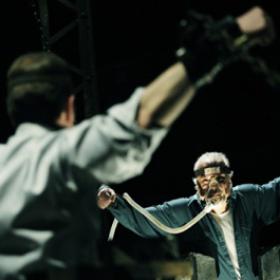Saw VI

0.5/5
If you haven’t seen any of the previous Saw movies, there‘s little reason to see Saw VI. Although you’ll manage to follow the main plot the rest of the movie will be lost on you, and, although it’s not the worst movie ever made, it’s certainly not worth twelve bucks. If you’ve seen all the previous Saw movies (and I have great sympathy for you if you have) you had might as well see this one because it’s better than parts IV and V, but not as good as I, II, or III. Besides, you’ve already put so much time into it you’d might as well keep going.
So far, the Saw sequels have been almost as excruciating as the Rube-Goldberg-esque torture machines they portray. The first Saw effectively titillated audiences. It wasn’t “torture porn” (no, it was the final scene from Mad Max in a basement – Editor). Rather, the suggestion and anticipation of gore made it delightfully uncomfortable while the rest of the movie was a puzzle for viewers to decipher. The sequels have left behind all that was good and focused on bizarre contraptions and impossibly complicated schemes. Gone were the well-known actors (Cary Elwes and Danny Glover); gone was the clever direction of James Wan; gone was any sense of moderation or finesse. Saw VI, directed by long-time Saw series editor Kevin Greutert, is no different.
Comprehensively retelling the plot of Saw VI would take longer than watching the film, and would probably be more enjoyable. For what you need to know, John “Jigsaw” Kramer (Tobin Bell), deceased since the end of Saw III, has post-mortemly sucked another sinner into his web of rusted-metal, flesh-tearing-devices, an HMO CEO named William Easton (Peter Outerbridge). Easton had previously denied coverage to Jigmalion for an experimental cancer treatment. Now, he finds himself in an abandoned zoo with explosives around his wrists and ankles. Like most of the previous saw films he has to go through a series of tasks involving other people, this time his staff. In one test after another he must decide who among them should live and who should die.
Wait, what? Since when did this become Michael Moore’s “Sicko?” Nope, it’s still Saw, and for the first time ever it’s socially relevant. This aspect of the film brings it a notch above many of the previous entries and makes it more easily digestible to wider audiences. Although the Saw series has always dealt with healthcare issues—and thinly veiled, uninspired moral dilemmas—this time it effectively makes a connection to current events. Moreover, if healthcare wasn’t enough there are two predatory lenders at the center of the pre-title torture vignette. It seems our pal Jig Newton is a staunch Obama supporter.
Elsewhere the anti-hero, Detective Hoffman (Costas Mandylor), who in the last three films we have learned has taken over for Jigger, is playing yet another game of cat and mouse with the FBI and Jig’s widow. Only a supercomputer could describe all the twists and turns in Hoffman’s involvement in the overall plot of Saw. Even if you were to watch all the six movies without a break in between, paying careful attention, with subtitles, and James Wan sitting next to you and pausing the more confusing scenes to explain them, you still wouldn’t know what the hell is going on.
But you don’t need to know. Saw delivers where it has always delivered; offering clever, disgusting, and sometimes impossible to watch scenes of brutal gore and maniacal devices. And, because that’s what most people want to see in a Saw film, those who enjoyed the other Saw movies will love this one. Furthermore, Saw falls short where it has always fallen short, offering little to no character development (does William Easton learn his lesson? Do we care?), robotic dialogue that only furthers the plot (unless it’s the Jigster’s dialogue, which is over-the-top, but at least entertaining), and a plot that is more complicated than it needs to be.
The one very impressive aspect of the Saw sequels is that they are actual sequels. They deal with the same characters and story lines as the other films, and in fact refer to each other and fill in little bits of plot along the way. However, while this is admirable in the creative sense it makes the movies that much harder for the uninitiated to watch, and requires you to remember much that you haven’t even thought about since last Halloween. The story isn’t good enough to warrant that many twists and complications. So, bring your popcorn and barf bags and suspend your disbelief, but be forewarned: by the end of the film you might want to switch places with the victims.
Starring: Tobin Bell, Costas Mandylor, Shawnee Smith, Peter Outerbridge, Tanedra Howard, Mark Rolston, Betsy Russell, James Van Patten, Jon Mack, Devon Bostick
Director: Kevin Greutert
Runtime: 90 min.
Distributor: Lions Gate
Rated: R
RELATED ARTICLES
Get the most-revealing celebrity conversations with the uInterview podcast!





Leave a comment